If you like cute fuzzy plants, you would probably also like cacti that are covered in hair.
Hairs on a cactus are an adaptation that helps the cactus repel insects, prevent water loss, and protect against cold temperatures.
The following species are considered hairy cacti and may have hairs that are thick, and thin, layering the entire cactus, or only growing in specific parts of the cactus.
1. Powder Puff Cactus (Mammillaria bocasana)
An attractive globose cactus native to Mexico, the Powder Puff Cactus produces small red or pink flowers in the summer and has a layer of thick white hairs, beneath which grow short, sharp spines.
The cactus’ flesh is bluish-green but is difficult to see beneath the thick hairs.
This cactus produces offshoots that group around the parent plant and can grow in clusters 2 – 4 feet (60 – 120 cm) wide.

(Tangopaso, Public domain, via Wikimedia Commons)
2. Discocactus zehntneri
This squat, solitary, oval hairy cactus has a single white flower that blooms from the top like a small umbrella.
The hairs are stiff and thicker than some cactus species and lie nearly flat against the body of the cactus instead of standing straight up.
The cactus grows 10 – 20 inches (25 – 50 cm) in diameter and up to 4 inches (10 cm) tall.

(PierreBraun, CC BY-SA 4.0, via Wikimedia Commons)
3. Three-Mile High Punotia (Austrocylindropuntia lagopus)
This cactus is low-growing cactus. It has a unique appearance in that it grows several smooth, rounded green growths through the thick cream-colored layer of wool on its apex, resembling a rabbit’s foot.
The hairs are soft, short, and dense, with longer hairs interspersed throughout. The cactus has no sharp spines.
The woolly tubercules grow from a single short, smooth stem and only grow a few inches (about 10 cm) in height.
This cactus also goes by the botanical name Austrocylindropuntia malyana.
4. Old Man Cactus (Cephalocereus senilis)
The Old Man Cactus is named because of its dense layer of white hairs, which make the columnar tubercules resemble beards.
The sharp spines aren’t visible, as they are covered by the thick woolly layer.
Old Man Cactus takes between 10 – 20 years to bloom, and when it does, it produces bright yellow, white, or deep red flowers that bloom overnight.
The columns can grow to a height of over 33 feet (10 meters) and are native to Mexico.
Other common names include Bunny Cactus and White Persian Cat Cactus.

(Rhododendrites, CC BY-SA 4.0, via Wikimedia Commons)
5. Golden Rat Tail (Cleistocactus winteri)
The Golden Rat Cactus is a trailing succulent ideal for hanging baskets.
It is named for the hairy tendrils that trail over the edges of pots that can reach up to 8 feet (2.5 meters) long. The hairs are soft and white with no spines.
During the spring and summer, bright red blossoms flower along the stems.
Monkey’s Tail Cactus is native to Bolivia and grows between rocks.
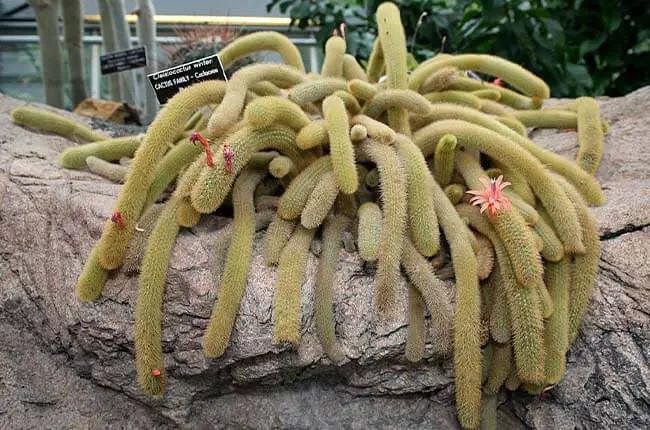
(Cliff from Arlington, Virginia, USA, CC BY 2.0, via Wikimedia Commons)
6. Peruvian Old Man Cactus (Espostoa lanata)
With the appearance of a gray beard, this woolly cylindrical cactus is native to Peru and is also called the Snowball Cactus or Cotton Ball Cactus.
The columns can grow up to 23 feet (7 meters) tall and 8 inches (20 cm) in diameter.
Funnel-shaped white or purple flowers bloom during the late spring and early summer in the nighttime.

(Rastaman3000, CC BY-SA 3.0, via Wikimedia Commons)
7. Grizzly Bear Prickly Pear (Opuntia polyacantha var. erinacea)
This hairy cactus has short, thin hairs that grow around the sharp spines.
It grows nearly 12 inches (30 cm) in height and grows in clusters 3 feet (90 cm) wide.
The flesh of the cactus is bluish green and bright pink or fuchsia flowers blossom during the spring.
As its name suggests, this species is one of the many varieties of prickly pear cactus.
This variety is called Grizzly Bear due to the number and sharpness of its spines, making it much spikier than other varieties of prickly pear.

(Evolvulux, CC BY-SA 4.0, via Wikimedia Commons)
8. Waraqu (Austrocylindropuntia floccosa)
The spines are barely visible through the whorls of thick, pale yellow wool on this globose cactus.
The stout bodies of the Waraqu – also called the Polar Bear Cactus – grow close together in expansive clusters and are often planted in dense rows to form natural barriers or groundcovers.
Each semi-globose tubercule grows about 6 inches (15 cm) tall and 2.5 inches (6 cm) in diameter, with the apex slightly pointed.
It produces small, round yellow flowers and edible fruit.

(Jim Sykes, CC BY-SA 4.0, via Wikimedia Commons)
9. Old Man of the Andes (Oreocereus celsianus)
True to its name, Old Man of the Andes is native to the Andes Mountains of South America.
Its columns are covered with a thick layer of white, woolly hairs, out of which reddish-orange spines protrude.
This cactus is popular in container gardens but can grow up to 10 feet (3 meters) tall and spread out in clusters 3 – 4 feet (1 meter) wide.
During the spring, it produces magenta flowers.

(Dornenwolf from Deutschland, CC BY 2.0, via Wikimedia Commons)
10. Park Pincushion Cactus (Pediocactus paradinei)
This globose cactus has dark green flesh and long, white, flaxen hairs interspersed with stiff spines.
The Park Pincushion Cactus is small and rounded, producing yellow, daisy-shaped flowers.
The cactus’s squat body is only 1.5 inches (4 cm) tall and 2 – 3 inches (5 – 8 cm) in diameter, lending to its diminutive common name. Despite its small size, the Park Pincushion Cactus has a taproot that grows up to 6 inches (16 cm) long.
It is native to the hot, arid deserts of Arizona.

(Paolo Neo, Public domain, via Wikimedia Commons)
11. Copao (Eulychnia saint-pieana)
The thick, dark green trunks of this columnar cactus grow to an impressive height of 33 feet (10 meters), each with a diameter of 4.5 inches.
Dense tufts of white hair grow on the sharp, long spines of the cactus-like small cotton patches.
White, bell-shaped flowers bloom during the late spring and early summer.
Eulychnia saint-pieana is native to Northern Chile.
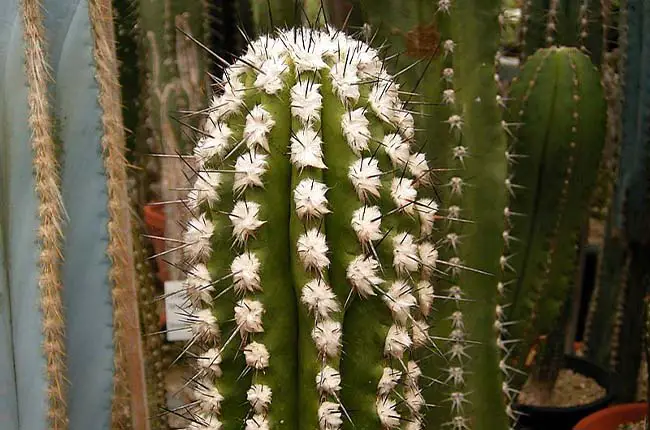
(Frank Vincentz, CC BY-SA 3.0, via Wikimedia Commons)
12. Hairy Stemmed Rhipsalis (Rhipsalis pilocarpa)
With woolly tendrils, the Hairy Stemmed Rhipsalis is true to its name. It is a low-maintenance trailing cactus best suited for hanging baskets.
Contrary to dessert cacti, Rhipsalis cacti are epiphytic cacti that prefer a humid environment.
The trailing tubercules grow up to 16 inches (41 cm) in length, initially growing upright before bending due to weight.
The hairs on this cactus are thin and short, with the bright green cactus flesh easily visible.
Small white flowers bloom during the fall and winter months.
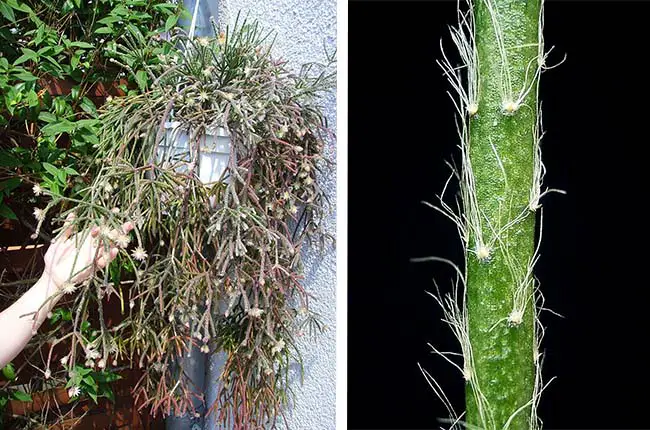
(Gerbil, CC BY-SA 3.0, via Wikimedia Commons)
13. Old Man Opuntia (Opuntia vestita)
This columnar cactus has bright green skin covered by long white hair that resembles wool.
The thin columns grow up to 25 inches (64 cm) tall and are about 1.5 inches (4 cm) in diameter.
The Old Man Opuntia is also known as Cotton Pole or Cotton Coral Cactus, due to the branching shape.

(Stickpen, Public domain, via Wikimedia Commons)
14. Geohintonia mexicana
Unlike many of the cactus species on this list, which generally have hairs all over the body of the cactus, Geohintonia mexicana only grows a patch of wool at the apex, from which pink flowers bloom.
This squat cactus grows 4 inches (10 cm) both wide and tall and has smooth, silvery green skin between its vertical spines.
This rare globose cactus only grows on the cliffs near Rayones, Mexico.
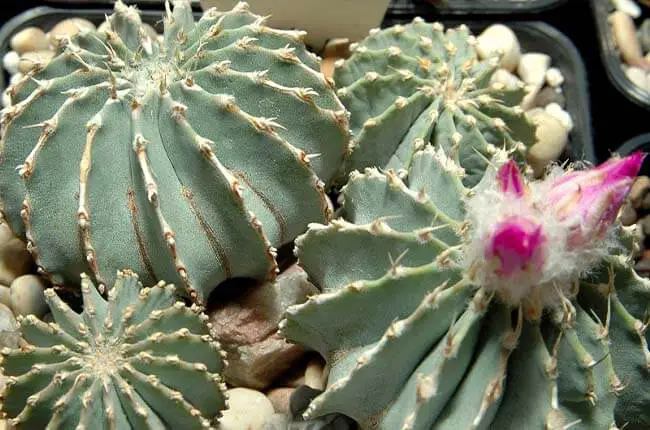
(Christer Johansson, CC BY-SA 2.5, via Wikimedia Commons)
15. Lava Cactus (Brachycereus nesioticus)
This incredibly rare cactus only grows on the Galapagos Island and is named for the golden color of its young, branchless columns.
New growth is gold or orange in color while older parts of the plant become gray with age.
The hairs are thin and erect between the spines, covering the skin of the plant.
The Lava Cactus grows in dense clusters in patches at least 6 feet (180 cm) wide, and each column grows as tall as 24 inches (61 cm).
The cactus produces creamy white blooms during the summer months and small, round red fruit.
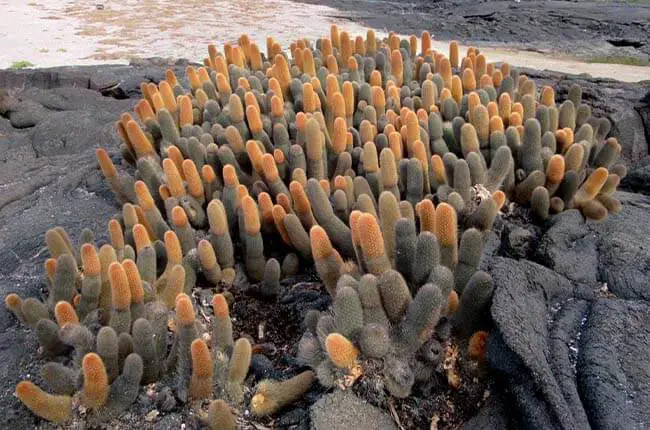
(David Stanley from Nanaimo, Canada, CC BY 2.0, via Wikimedia Commons)
16. Cleistocactus jujuyensis
This unique cactus produces asymmetrical columns that wind and twist in vine-like shapes.
While not as hairy or woolly as many of the other entries on our list, this cactus has small, concentrated spots of short, tiny hairs surrounding a single erect spine.
It also goes by the botanical name Cleistocactus hyalacanthus.

(Stan Shebs, CC BY-SA 3.0, via Wikimedia Commons)
17. Teddy Bear Cholla (Cylindropuntia bigelovii)
Named for its woolly, curved ‘arms’ that resemble those of a teddy bear, the tree-like Teddy Bear Cholla has thick, stiff yellow hairs that stick straight out.
Resembling a tree, this cactus can grow between 3 – 8 feet (90 – 240 cm) both tall and wide.
In spring and summer, it produces round yellow blooms.

(Thayne Tuason, CC BY 4.0, via Wikimedia Commons)
18. Cleistocactus ritteri
This woolly columnar cactus is part of the Cleistocactus genus – a group of cacti often referred to as Silver Torch or Woolly Torch due to its thick layer of thin silvery hairs. The hairs are stiff and bristly, despite their soft appearance.
This branchless cactus grows erect in thin columns, each of which is roughly 3 inches (8 cm) in diameter and up to 3.5 feet (1 meter) tall.
Its tubular yellow flowers bloom from the sides of the columns near the top.
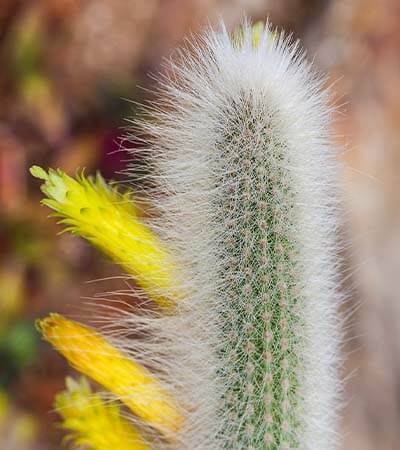
(Diego Delso, CC BY-SA 3.0, via Wikimedia Commons)
19. Snow Pole (Espostoopsis dybowskii)
This columnar cactus species is named for its tall columns covered in thick white hairs that resemble a layer of cotton. It is a tropical growing cactus and can tolerate more humid conditions than cacti that grow in arid climates.
Snow Pole reaches an impressive mature height of 6 – 13 feet (1.8 – 4 meters) tall, with each erect column having no branches. The columns are thin in proportion to their height, having an average diameter of 3 inches (8 cm).
As its scientific name suggests, this cactus species is very similar to the genus Espostoa.
Related
13 Stunning Cacti by Flower Color
Top 10 Little-Known Spiral Cactus
- Keiki Paste vs Rooting Hormone:What’s the difference? - February 4, 2024
- Top 10 Orchid Fertilizers: A Comprehensive Review (2024) - February 2, 2024
- Top 8 Soil Inoculants For Stronger Plants (2024) - February 1, 2024

